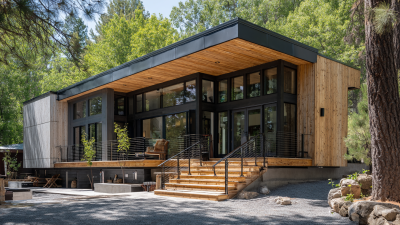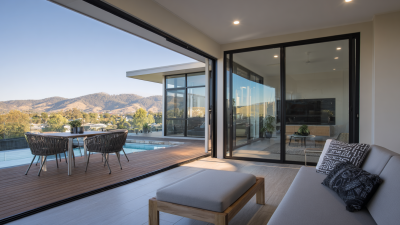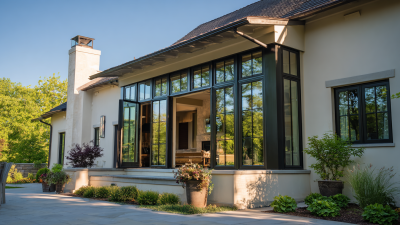Blog
Exploring Innovative Alternatives in Windows and Doors: A Global Procurement Perspective on Sustainability and Efficiency
In an era where sustainability and efficiency are paramount, the search for innovative alternatives in the realm of windows and doors has never been more critical. These essential components of our built environment not only contribute significantly to energy conservation but also play a vital role in enhancing the aesthetic appeal and functionality of spaces. As global procurement strategies evolve, stakeholders are increasingly prioritizing materials and technologies that minimize environmental impact while maximizing performance. This blog will delve into the emerging trends and practices in the windows and doors sector, exploring how industry leaders are embracing creativity and innovation to meet the dual demands of sustainability and efficiency. By examining case studies and insights from around the globe, we aim to shed light on the future of windows and doors, driving conversations that inspire change and progress in the construction and design sectors.

Innovative Materials for Sustainable Windows and Doors in Global Markets
 The search for sustainable solutions in the construction industry has led to the development of innovative materials for windows and doors that not only enhance energy efficiency but also minimize environmental impact. Today, manufacturers are exploring alternatives such as reclaimed wood, recycled aluminum, and advanced composite materials. These materials are not only durable but also have a lower carbon footprint compared to traditional options. For instance, windows crafted from recycled materials can significantly reduce waste while maintaining performance metrics, such as insulation and soundproofing.
The search for sustainable solutions in the construction industry has led to the development of innovative materials for windows and doors that not only enhance energy efficiency but also minimize environmental impact. Today, manufacturers are exploring alternatives such as reclaimed wood, recycled aluminum, and advanced composite materials. These materials are not only durable but also have a lower carbon footprint compared to traditional options. For instance, windows crafted from recycled materials can significantly reduce waste while maintaining performance metrics, such as insulation and soundproofing.
Moreover, the trend towards sustainability is prompting a shift in global procurement practices. Companies are now prioritizing suppliers who adhere to eco-friendly production methods and who source raw materials responsibly. The integration of biophilic design principles is also gaining traction, with products that incorporate natural elements improving both aesthetic appeal and functionality. As more businesses recognize the importance of sustainability, the demand for innovative windows and doors is expected to grow, driving further advancements in material technology and the adoption of green practices across global markets.
Evaluating Energy Efficiency: Strategies for Modern Window and Door Solutions
The evolving landscape of window and door solutions has led to an increased emphasis on energy efficiency, a critical factor in sustainable building practices. Modern innovations in materials, such as triple-glazed glass and advanced framing systems, significantly enhance thermal performance. These upgrades reduce the reliance on artificial heating and cooling, thus contributing to lower energy consumption and greenhouse gas emissions. Homeowners and builders alike are increasingly prioritizing these advancements, recognizing their long-term benefits not only for the environment but also for energy bills.
In the quest for efficiency, strategic procurement plays a pivotal role. Manufacturers are now sourcing materials that are not only sustainable but also optimized for energy performance. This means considering lifecycle assessments and sourcing practices that minimize carbon footprints. Collaborations between architects, builders, and suppliers are essential to ensure that the latest energy-efficient solutions are integrated seamlessly into projects. By prioritizing procurement strategies that emphasize sustainability, the construction industry can significantly influence energy conservation across the globe, setting new standards in the realm of modern window and door solutions.
Exploring Innovative Alternatives in Windows and Doors: A Global Procurement Perspective on Sustainability and Efficiency
| Dimension | Category | Energy Efficiency Rating | Sustainability Features | Procurement Cost ($) |
|---|---|---|---|---|
| Window A | Triple-Glazed | A++ | Recycled materials, Low VOC | 350 |
| Window B | Double-Glazed | A+ | Recyclable frame, Energy Star certified | 250 |
| Door A | Insulated | A++ | Sustainable wood, Low energy consumption | 400 |
| Door B | Fiberglass | A+ | Recycled content, Thermally broken frame | 300 |
Case Studies: Successful Implementations of Eco-friendly Alternatives
In the quest for sustainability, the building materials industry has begun to explore and adopt innovative alternatives that align with eco-friendly principles. The recent emphasis on sustainable practices in various sectors, including the automobile industry, highlights a broader push for materials that minimize the environmental impact. Case studies from manufacturers of windows and doors have showcased the successful implementation of eco-friendly solutions that not only reduce harmful greenhouse gas emissions but also enhance the overall efficiency of buildings.
One standout example involves a company that transitioned to using recycled composite materials for its window frames, significantly lowering waste and energy consumption during production. The positive outcomes from this initiative demonstrate how sustainable practices can lead to improved product performance and consumer satisfaction. As industries continue to innovate and share their success stories, it becomes increasingly clear that adopting eco-friendly alternatives is both a necessity and an opportunity for growth, encouraging others within the sector to follow suit and rethink their approaches to materials procurement.
Global Trends in Procurement: Shifting Towards Sustainable Building Practices
 As the global construction industry evolves, there is a noticeable shift towards sustainable building practices in procurement processes, particularly in the windows and doors sector. This transition is driven by a combination of regulatory pressure, consumer demand for environmentally friendly products, and the realization that sustainability can lead to long-term cost savings. Companies are now prioritizing materials that not only meet performance standards but also have a lower environmental impact.
As the global construction industry evolves, there is a noticeable shift towards sustainable building practices in procurement processes, particularly in the windows and doors sector. This transition is driven by a combination of regulatory pressure, consumer demand for environmentally friendly products, and the realization that sustainability can lead to long-term cost savings. Companies are now prioritizing materials that not only meet performance standards but also have a lower environmental impact.
Tip: Consider sourcing materials that are locally produced to reduce transportation emissions, which contributes directly to a smaller carbon footprint. Companies should also embrace innovation by exploring advanced materials and energy-efficient designs that align with sustainable objectives. The integration of technologies such as energy modeling during the design phase helps identify opportunities for reducing resource consumption upfront.
Tip: Evaluate suppliers based on their sustainability practices, certifications, and ability to deliver eco-friendly products. As stakeholders increasingly demand transparency and accountability, procuring from vendors who adhere to sustainable practices not only enhances a company's reputation but also secures a competitive edge in the market. The journey toward sustainable procurement is not just a trend; it is becoming essential for long-term viability in the construction industry.
Future Outlook: The Role of Technology in Enhancing Efficiency and Sustainability
As the demand for sustainable construction materials intensifies, the role of technology in enhancing efficiency and sustainability within the windows and doors industry becomes increasingly critical. According to a report by MarketsandMarkets, the global green building materials market is projected to reach $609.99 billion by 2027, growing at a CAGR of 11.6% from 2022. This growth reflects a shift towards environmentally friendly options, prompting manufacturers to invest in innovative technologies that reduce waste, energy consumption, and carbon emissions during production.
Smart technology is at the forefront of this transformation, enabling features such as automated energy management systems, real-time monitoring of thermal performance, and the integration of renewable resources. For example, digitally powered windows are being developed to automatically adjust transparency and insulation based on environmental conditions, which can lead to a 20% reduction in energy costs according to the International Energy Agency. As the industry embraces these advancements, the synergy between technology and sustainable practices will be crucial in shaping a resilient and eco-friendly future for windows and doors.
Exploring Innovative Alternatives in Windows and Doors
This chart illustrates the importance ranking of various innovative alternatives in the context of sustainability and efficiency in windows and doors procurement. A higher score indicates greater importance, reflecting current trends and future outlooks in the industry.
Related Posts
-

Revolutionizing Spaces: Real-Life Applications of the Best Windows and Siding in Sustainable Construction
-

How to Source the Best Door Window Suppliers for Your Global Procurement Needs
-

Navigating Global Trade Certifications for the Best Windows and Siding Solutions
-

How to Identify Top Suppliers for the Best Sliding Patio Doors: A Global Buyers' Guide
-

How to Choose the Best Exterior Doors: Key Features and Trends for 2023
-

The Future of Awning Windows: Innovations and Trends Shaping Tomorrow's Design
About Us
We serve the Greater Milwaukee area: Waukesha, Milwaukee, Washington, Ozaukee Counties and nearby areas, including Germantown, Menomonee Falls, Mequon, Cedarburg, Thiensville, Grafton, Jackson, West Bend, Hartland, Waukesha, Brookfield, West Allis, Franklin, Greenfield and more. We are Wisconsin’s Best Contractor for Replacement Windows, Doors, Siding & Roofing!
Contact Details
Address:
N112 W14880 Mequon Road
Germantown, Wisconsin 53022
Phone:
Email:
Showroom Hours
Monday: 9am – 5pm
Tuesday: 9am – 5pm
Wednesday: 9am – 5pm
Thursday: 9am – 5pm
Friday: 9am – 4:30 pm
Saturday by Appointment
Evenings by Appointment



